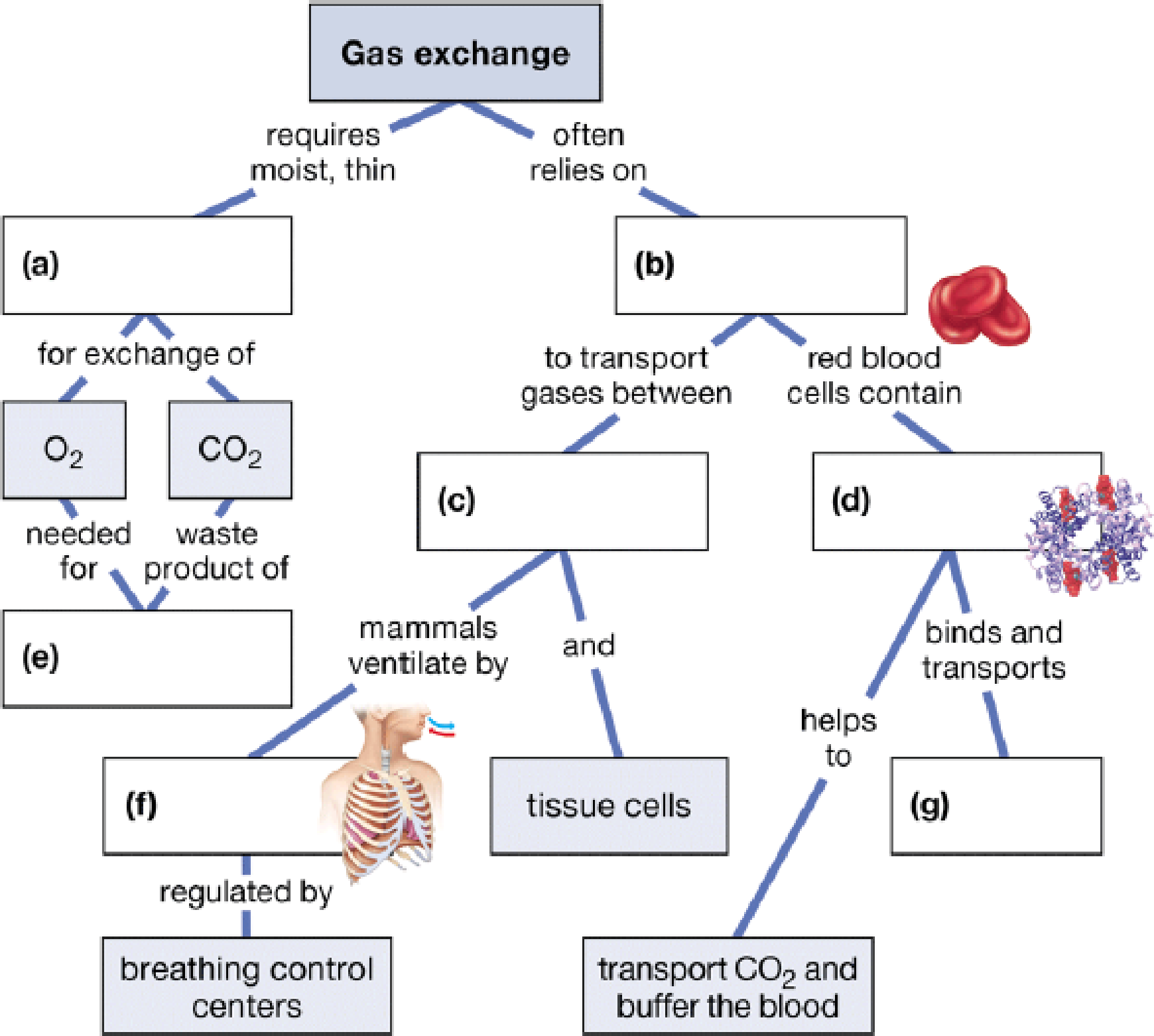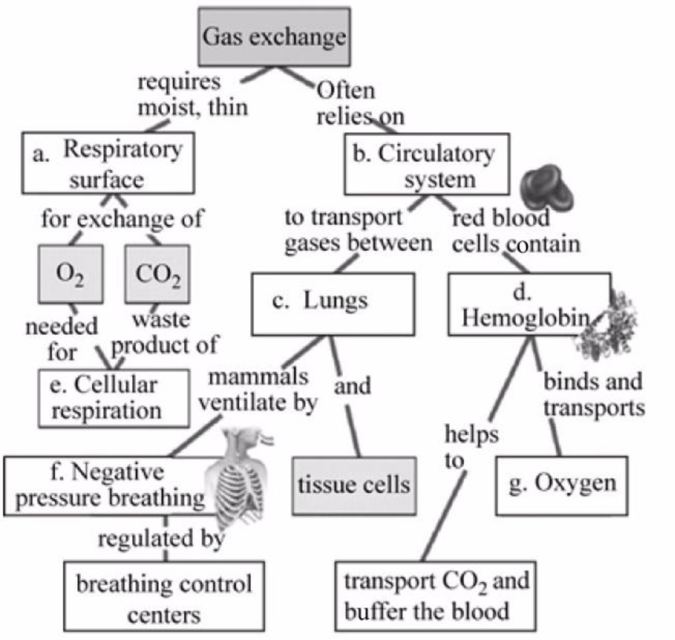
Concept explainers
Complete the following concept map to review some of the concepts of gas exchange.

To complete: The given map to review some of the concepts of gas exchange.
Introduction:
The respiratory system is a biological system that ensures the transport of air by the process of inhalation and exhalation, that is, in and out the body with the help of the lungs.
Answer to Problem 1CC
Fig.1 shows the completed map to review some of the concepts of gas exchange.
Pictorial representation: Some of the concepts related to gas exchange are presented in the concept map given in Fig.1.

Fig.1: Concepts of gas exchange.
Explanation of Solution
a.
Correct answer: Respiratory surface.
For gas exchange to occur, the respiratory surface should be thin and moist. Hence, the correct answer is the respiratory surface.
b.
Correct answer: Circulatory system.
Gas exchange relies on the circulatory system as the exchanged oxygen and carbon dioxide travel in the blood to the heart and different body cells. Hence, the correct answer is the circulatory system.
c.
Correct answer: Lungs
It is the main organ for the exchange of gases consisting of air sacs that carry out gaseous exchange and the blood carries the exchanged gas to the tissue cells. Hence, the correct answer is the lungs.
d.
Correct answer: Hemoglobin.
Hemoglobin is a blood pigment present inside the red blood cell, which helps in the transport of oxygen and carbon dioxide by binding with it and also maintains the pH of the blood. Hence, the correct answer is hemoglobin.
e.
Correct answer: Cellular respiration.
In cellular respiration, oxygen is used to convert glucose into carbon dioxide, water, and energy in the form of ATP. Hence, the correct answer is cellular respiration.
f.
Correct answer: Negative pressure breathing.
This type of breathing is regulated by the “breathing control center of the brain”. In negative pressure breathing, the air pressure inside the lungs drops during the contraction of the diaphragm, and the lower portion of the chest cavity rises; this allows the movement of air from outside to inside. Hence, the correct answer is negative pressure breathing.
g.
Correct answer: Oxygen.
Hemoglobin pigment in the blood binds with the oxygen present in the lungs, and this oxygen is utilized to form energy. Hence, the correct answer is oxygen.
Want to see more full solutions like this?
Chapter 22 Solutions
CAMPBEL BIOLOGY:CONCEPTS & CONNECTIONS
- In one paragraph show how atoms and they're structure are related to the structure of dna and proteins. Talk about what atoms are. what they're made of, why chemical bonding is important to DNA?arrow_forwardWhat are the structure and properties of atoms and chemical bonds (especially how they relate to DNA and proteins).arrow_forwardThe Sentinel Cell: Nature’s Answer to Cancer?arrow_forward
- Molecular Biology Question You are working to characterize a novel protein in mice. Analysis shows that high levels of the primary transcript that codes for this protein are found in tissue from the brain, muscle, liver, and pancreas. However, an antibody that recognizes the C-terminal portion of the protein indicates that the protein is present in brain, muscle, and liver, but not in the pancreas. What is the most likely explanation for this result?arrow_forwardMolecular Biology Explain/discuss how “slow stop” and “quick/fast stop” mutants wereused to identify different protein involved in DNA replication in E. coli.arrow_forwardMolecular Biology Question A gene that codes for a protein was removed from a eukaryotic cell and inserted into a prokaryotic cell. Although the gene was successfully transcribed and translated, it produced a different protein than it produced in the eukaryotic cell. What is the most likely explanation?arrow_forward
- Molecular Biology LIST three characteristics of origins of replicationarrow_forwardMolecular Biology Question Please help. Thank you For E coli DNA polymerase III, give the structure and function of the b-clamp sub-complex. Describe how the structure of this sub-complex is important for it’s function.arrow_forwardMolecular Biology LIST three characteristics of DNA Polymerasesarrow_forward
- Basic Clinical Lab Competencies for Respiratory C...NursingISBN:9781285244662Author:WhitePublisher:Cengage
 Anatomy & PhysiologyBiologyISBN:9781938168130Author:Kelly A. Young, James A. Wise, Peter DeSaix, Dean H. Kruse, Brandon Poe, Eddie Johnson, Jody E. Johnson, Oksana Korol, J. Gordon Betts, Mark WomblePublisher:OpenStax College
Anatomy & PhysiologyBiologyISBN:9781938168130Author:Kelly A. Young, James A. Wise, Peter DeSaix, Dean H. Kruse, Brandon Poe, Eddie Johnson, Jody E. Johnson, Oksana Korol, J. Gordon Betts, Mark WomblePublisher:OpenStax College





